AUDI R8 SPYDER 2012 Owners Manual
Manufacturer: AUDI, Model Year: 2012, Model line: R8 SPYDER, Model: AUDI R8 SPYDER 2012Pages: 236, PDF Size: 59.24 MB
Page 141 of 236
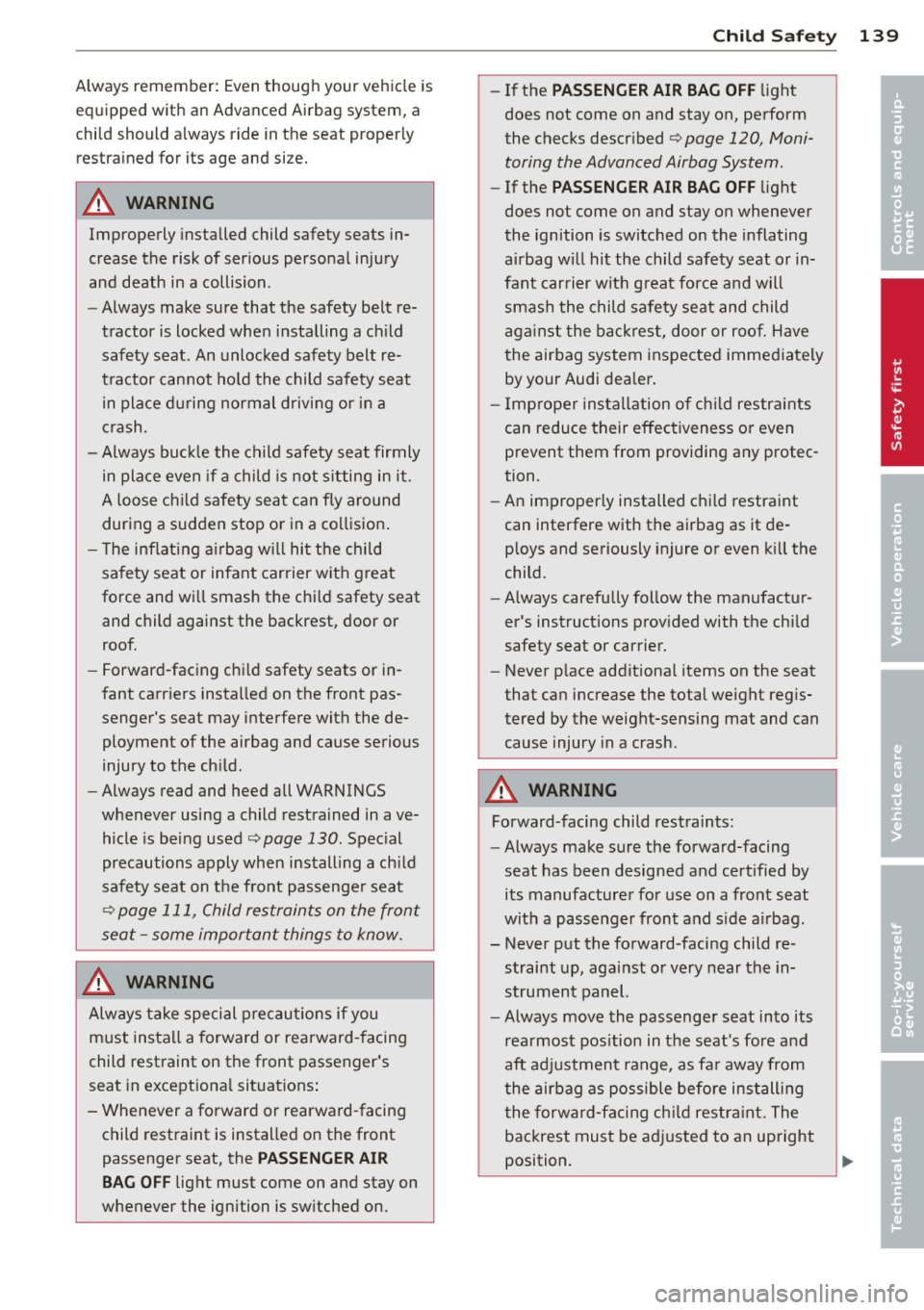
Always remember: Even though your vehicle is
equipped with an Advanced Airbag system, a
child should always ride in the seat properly
restrained for its age and size.
_&. WARNING
Improperly installed child safety seats in
crease the risk of serious personal injury
and death in a collision.
- Always make sure that the safety belt re
tractor is locked when installing a child
safety seat. An unlocked safety belt re
tractor cannot hold the child safety seat
in place during normal driving or in a
crash .
- Always buckle the child safety seat firmly
in place even if a child is not sitting in it.
A loose child safety seat can fly around
during a sudden stop or in a collision.
- The inflating airbag will hit the child
safety seat or infant carrier with great
force and will smash the child safety seat
and child against the backrest, door or
roof.
- Forward-facing child safety seats or in
fant carriers installed on the front pas
senger's seat may interfere with the de ployment of the airbag and cause serious
injury to the child.
- Always read and heed all WARNINGS
whenever using a child restrained in ave
hicle is being used
c:::;, page 130. Special
precautions apply when installing a child
safety seat on the front passenger seat
c:::;, page 111, Child restraints on the front
seat -some important things to know.
_&. WARNING
-
Always take special precautions if you
must install a forward or rearward-facing
child restraint on the front passenger's
seat in exceptional situations:
- Whenever a forward or rearward-facing child restra int is installed on the front
passenger seat, the
PASSENGER AIR
BAG OFF
light must come on and stay on
whenever the ignition is switched on.
Child Safety 139
-If the PASSENGER AIR BAG OFF light
does not come on and stay on, perform
the checks described
c:::;, page 120, Moni
toring the Advanced Airbag System.
- If the PASSENGER AIR BAG OFF light
does not come on and stay on whenever
the ignition is switched on the inflating
airbag will hit the child safety seat or in
fant carrier with great force and will
smash the child safety seat and child
against the backrest, door or roof. Have
the airbag system inspected immediately
by your Audi dealer.
- Improper installation of child restraints
can reduce their effectiveness or even prevent them from providing any protec
tion.
- An improperly installed child restraint
can interfere with the airbag as it de
ploys and seriously injure or even kill the
child.
- Always carefully follow the manufactur
er's instructions provided with the child
safety seat or carrier.
- Never place additional items on the seat
that can increase the total weight regis
tered by the weight-sensing mat and can
cause injury in a crash.
_&. WARNING
Forward-facing child restraints:
- Always make sure the forward-facing
seat has been designed and certified by
its manufacturer for use on a front seat
with a passenger front and side airbag.
- Never put the forward-facing child re straint up, against or very near the in
strument panel.
- Always move the passenger seat into its
rearmost position in the seat's fore and
aft adjustment range, as far away from
the airbag as possible before installing
the forward-facing child restraint. The
backrest must be adjusted to an upright
position. •
•
Page 142 of 236
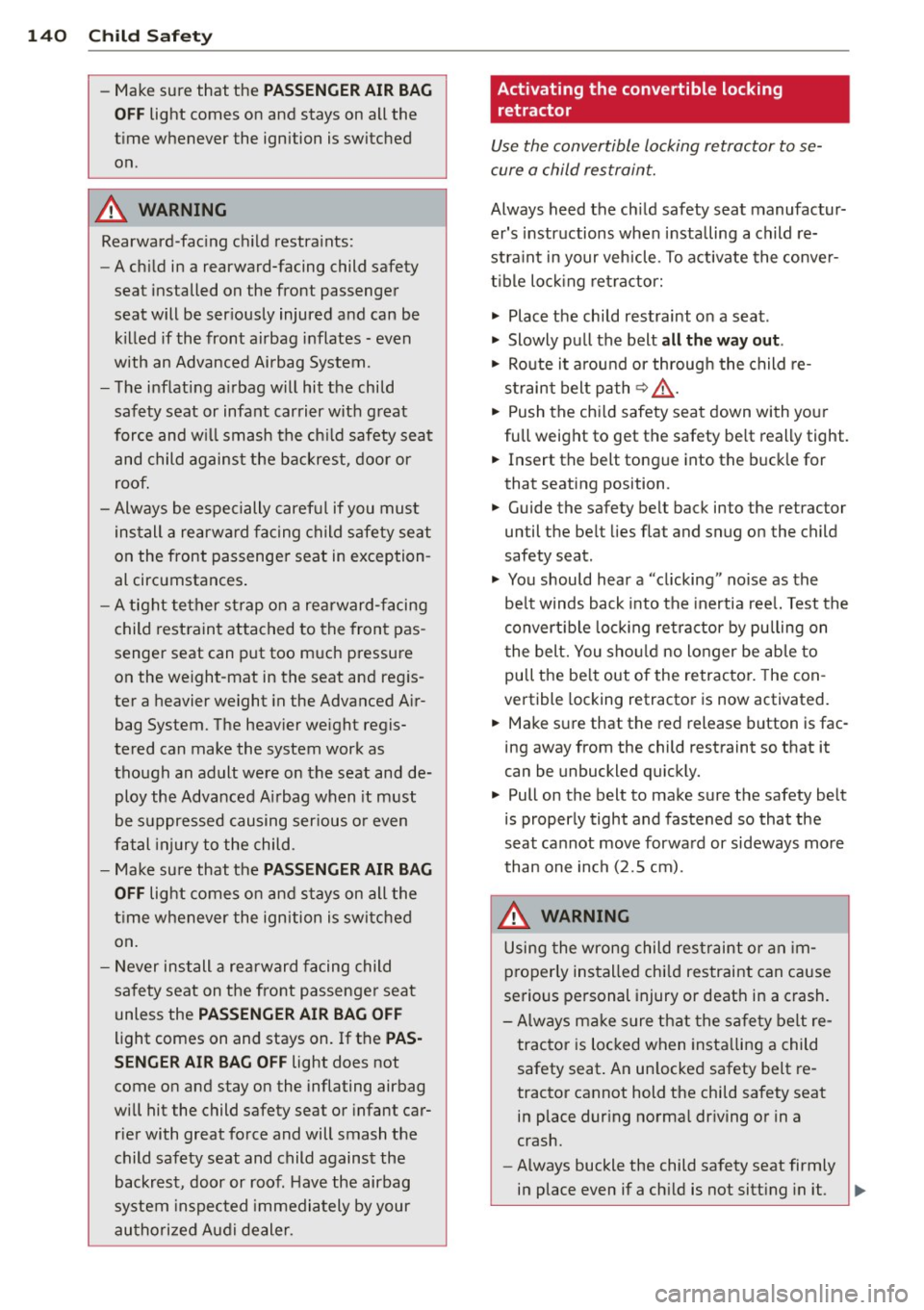
140 Child Saf ety
- Make sure that the PASSENGER AIR BAG
OFF
light comes on and stays on all the
time whenever the ignition is switched on .
A WARNING
Rearward -fac ing c hild restra ints:
- A ch ild in a rearward-facing child safety
seat installed on the front passenger
seat will be ser iously injured and can be
killed if the front airbag inflates - even
with an Advanced Airbag System.
- The inflating a irbag will hit the child
safety seat or infant carrier wit h great
force and w ill smash the ch ild safety seat
and child against the b ackrest , door or
roof.
- Alway s be espe cially caref ul if you must
ins tall a re arwa rd fa cing child s afety seat
on the front passenge r seat in exception
al circumstances .
- A tight tet her strap on a rearward-facing
child rest raint attached to the front pas
senger seat can put too much pressu re
on the weight-mat in the seat and reg is
ter a heavier weight in the Advanced A ir
bag System. The heav ier we ight regis
tered can make the system work as
though an adult were on the seat and de
ploy the Advanced Ai rbag when it must
be s uppressed causing ser ious o r even
f a tal injury to the child .
- Make su re that the
PASSENGER AIR BAG
OFF
light comes on and stays on all the
t ime whenever the ignition is switched
on.
- Never install a rearward facing child
safety seat on the front passenger seat
unless the
PASSENGER AIR BAG OFF
light comes on and stays on . If t he PAS·
SENGER AIR BAG OFF
light does not
come on and stay on the inflating airbag
will hit the child safety seat or infant car
rie r with great fo rce and will smash the
child safety seat and child against the
backrest, door or roof. Have the airbag
system inspected immedia tely by your
au thori zed Au di d ealer .
Activating the convertible locking
retractor
Use the convertible locking retractor to se
cu re a child re strain t.
Always heed the ch ild safety sea t manufactur
er's instr uctions when installing a child re
st ra in t in your veh icle . To a ctivate the conve r
t ible lo cking re tractor:
" Place t he child res traint o n a seat .
" Slowly pu ll the belt
all the way out .
" Route it a round or throug h the child re
s train t belt pa th
~ ,& .
" Push the ch ild safety sea t down wi th yo ur
full weight to get t he safety be lt really tight.
" Insert the belt tong ue into the b uckl e for
that seating position .
" Guide the safety be lt back into the retractor
until the be lt lies flat and snug o n the child
safety seat.
" You should hear a "cl icking " noise as the
be lt winds back into the inertia ree l. Test the
convert ible lo cki ng re tr actor by pulling on
t he belt. You s hould no longer be ab le to
pull t he be lt out of the retrac to r. T he con
vertible locking retracto r is now activated .
" Ma ke s ure that the red release b utton is fac
ing away from the child restraint so that it
can be unbuckled quick ly.
" Pull on the belt to make sure the safety belt
is properly tight and fastened so that the
s e at ca nnot move forwa rd or sideways more
than one inch ( 2.S cm).
A WARNING
Using the wrong child res traint o r an i m
pr operly ins talled chi ld restraint can cause
se rious pe rsonal injury or deat h in a c rash.
- Always ma ke sure tha t t he safe ty belt re-
trac to r i s loc ked when insta lling a child
safety seat. An un locke d safety belt re
tracto r cannot hold the child safety seat
in place dur ing norma l dr iving o r in a
crash.
- Always buckle the child sa fety seat firmly
-
in place even if a ch ild is not sitt ing in it. ~
Page 143 of 236
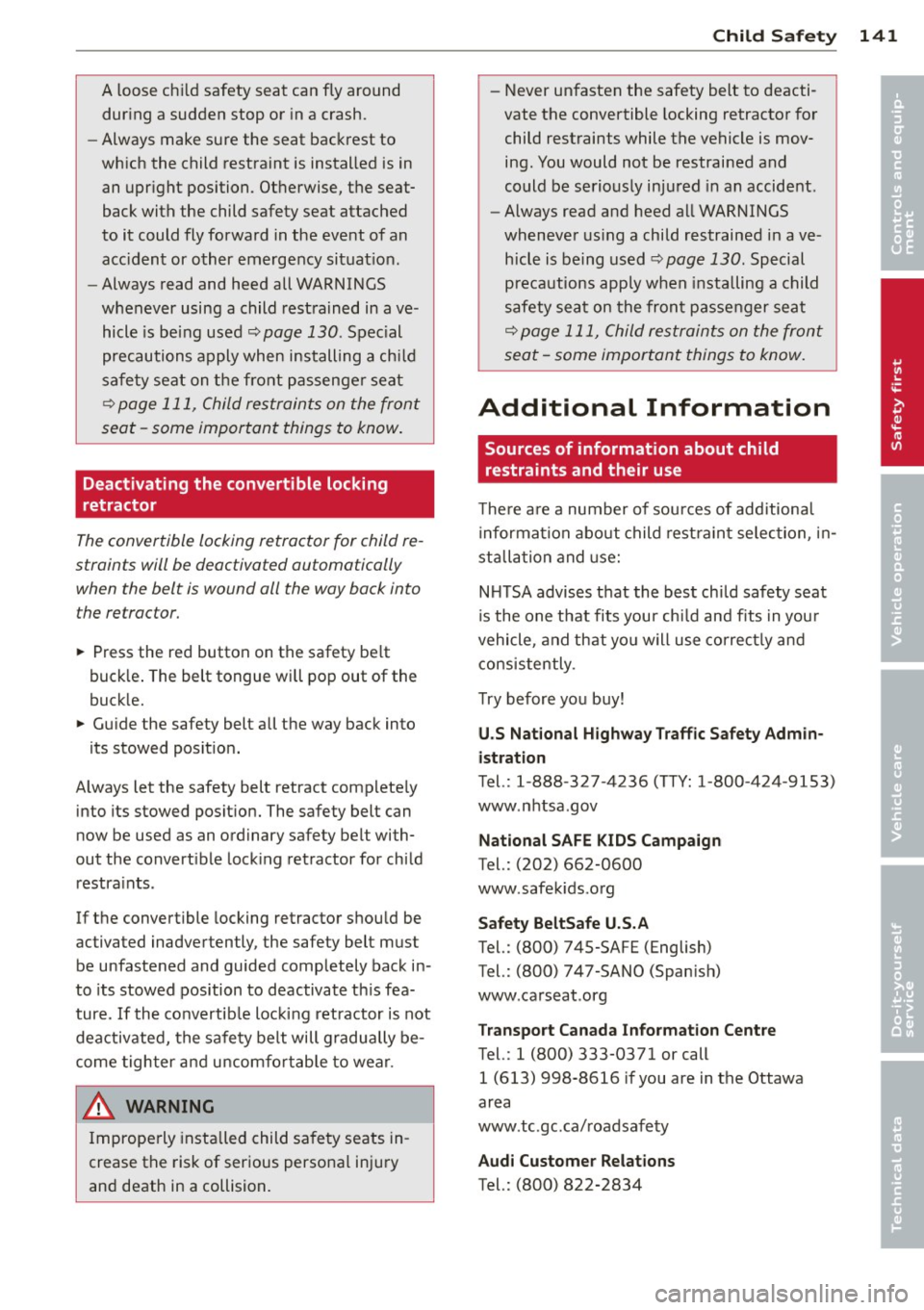
A loose chi ld safety seat can fly around
dur ing a sudden stop or in a crash.
- Always make sure the seat backrest to
wh ich the child restraint is installed is in
an upr ight position . Otherwise, the seat
back with the child safety seat attached
to it could fly forward in the event of an
acc ident or other emergency situat ion.
- Always read and heed all WARNINGS
whenever using a child rest rain ed in ave
hicle is being used
~page 130. Spec ial
precautions apply when installing a ch ild
sa fety sea t on the fron t passenge r sea t
~ page 111, Child restrain ts on the fron t
seat -some impor tant things to know.
Deactivating the convertible locking
retractor
The convertible locking retractor for child re
straints will be deactivated automatically
when the belt is wound all the way back into the retractor.
~ P ress the red button on the safety be lt
buck le . The belt tongue will pop out of the
buck le.
~ G ui de the safety belt all the way back into
i ts stowed posit ion.
A lways let the safety belt retract comp lete ly
into its stowed posit ion. The safety belt can
now be used as an ord inary safety belt with
out the convert ible lock ing retractor for chi ld
restra ints .
If the convert ible locking retractor s hou ld be
activated inadvertently, the safety belt must be unfastened and guided completely back in
to its stowed position to deactivate th is fea
ture . If the convertib le loc king retractor is not
deactivated, the safe ty belt will g radua lly be
come tighter and uncomfo rt a b le to wear .
A WARNING
Imprope rly insta lled child sa fe ty seats in
crease the risk of ser ious personal inju ry
and death in a collision .
Child Safet y 141
-Never unfasten the safety belt to deacti
vate the convertible locking retracto r for
child restraints while the vehicle is mov
ing. You would not be restrained and
could be serious ly inju red in an accide nt.
- Always read a nd heed a ll WARNI NGS
wheneve r us ing a child restrained in ave
hicle is being used
Q page 130 . Special
prec autions app ly wh en insta lling a child
safety sea t on the fro nt passe nger seat
Q page 111, Child restraints on the fron t
seat -some important things to know.
Additional Information
Sources of information about child
restraints and their use
T he re a re a number of sources of additiona l
in forma tion a bout child re st ra in t se lec tion, in
stalla tion and use:
N HTSA advises that the best ch ild safety seat
i s the one t hat fits you r ch ild and fits in you r
vehicle, and that yo u will u se correc tly and
c onsistently.
Try before you buy!
U .S National Highway Traffic Safety Admin
istration
Tel.: 1-888-327-4236 (TTY: 1 -800 -424 -9153)
www . n htsa .gov
National SAFE KIDS Campaign
Tel.: (202) 662-0600
www .safe kids .org
Safety BeltSafe U.S.A
Tel.: (800) 7 45-SAFE (English)
Tel.: (800) 747-SANO (Span is h)
www .carseat .org
T ransport Canada Information Centre
Tel.: 1 (800) 333-03 71 or call
1 (613) 998-8616 if you are in the Ottawa
area
www .tc .gc.ca/ roadsafe ty
Audi Customer Relations
Tel.: (800) 822-2834 •
•
Page 144 of 236

142 Intelligent technology
Intelligent technology
Notice about data
recorded by vehicle
control modules
Your veh icle is not equipped with an Event Da
ta Recorder (EDR), installed by some manu
facture rs fo r the express p urpose o f capturing
data for retrieval after an accident or cras h
event. EDR's are sometimes called "crash re
corders".
Some state laws res trict the retrieval or down
loading of data stored by EDR's that were in
stalled in a vehicle for the express purpose of retrieving data after an accident or crash
event without the owner's consent.
A lthough yo ur vehicle is not equ ipped wit h an
EDR, it is equipped with a number of elect ron
ic control modules for various vehicle systems
such as, for examp le, eng ine function, emis
sion control, as well as for the airbags and
safety belts.
These electron ic control modules also record
vehicle-re lated data during norma l vehicle op
eration for diagnostic and repa ir purposes.
The recording capacity of the electronic con
trol modules is limited to data (no sound is re
corded) and only a small amount of data is ac
tually recorded ove r a ve ry limited pe riod of
time and stored when a sys tem fault or other
condition is sensed by a cont ro l u nit. Some of
the data then stored may re late to vehicle
speed, direction, braking as we ll as restraint
system use and performance in the event of a
crash or other condition. Stored data can only be read and downloaded w ith special equip
ment .
Electronic Stability
Control (ESC)
The Electronic Stability Control increases driv
ing stability.
F ig . 1 31 Center console with~ button
Intent and purpose
The Anti-Lock B ra ke System (ABS), Elec tronic
Differential Lo ck (EDL) and Anti-Slip Regula
tion System (ASR) are integrated i n the Elec
tronic Stability Control (ESC). It increases con
tro l over the vehicle in handling conditions
close to the limit of "grip", such as when ac
celerating and corner ing. It reduces the risk of
skidding under all road condit ions and at all
speeds and improves veh icle stability. When
road cond itions are poor, ESC makes it easier
to sta rt from a comp lete s top as we ll as accel
era te and drive up hills. ESC sw itches on auto
matically when yo u start the engine . It should
norma lly be activated at all times because this
ensures optimum vehicle stability .
Critical driving situations
With an overs teering vehicle ( the vehicle
tu rns too s harply and the rear wheels slide to
ward the o utsi de of a curve), ESC primarily
brakes the outside front wheel, with an
un
dersteering vehicle (the vehicle does not turn
sharp ly enough and pushes out of a curve) it
brakes the inside rear whee l or other addition
al wheels. This brake inte rvent ion is accompa
nied by noises.
If the speed of a wheel s lows down too much
relat ive to vehicle speed while braking and it
starts to lock, brake pressure to this whee l is
reduced . This adjustment process can be felt ..,.
Page 145 of 236
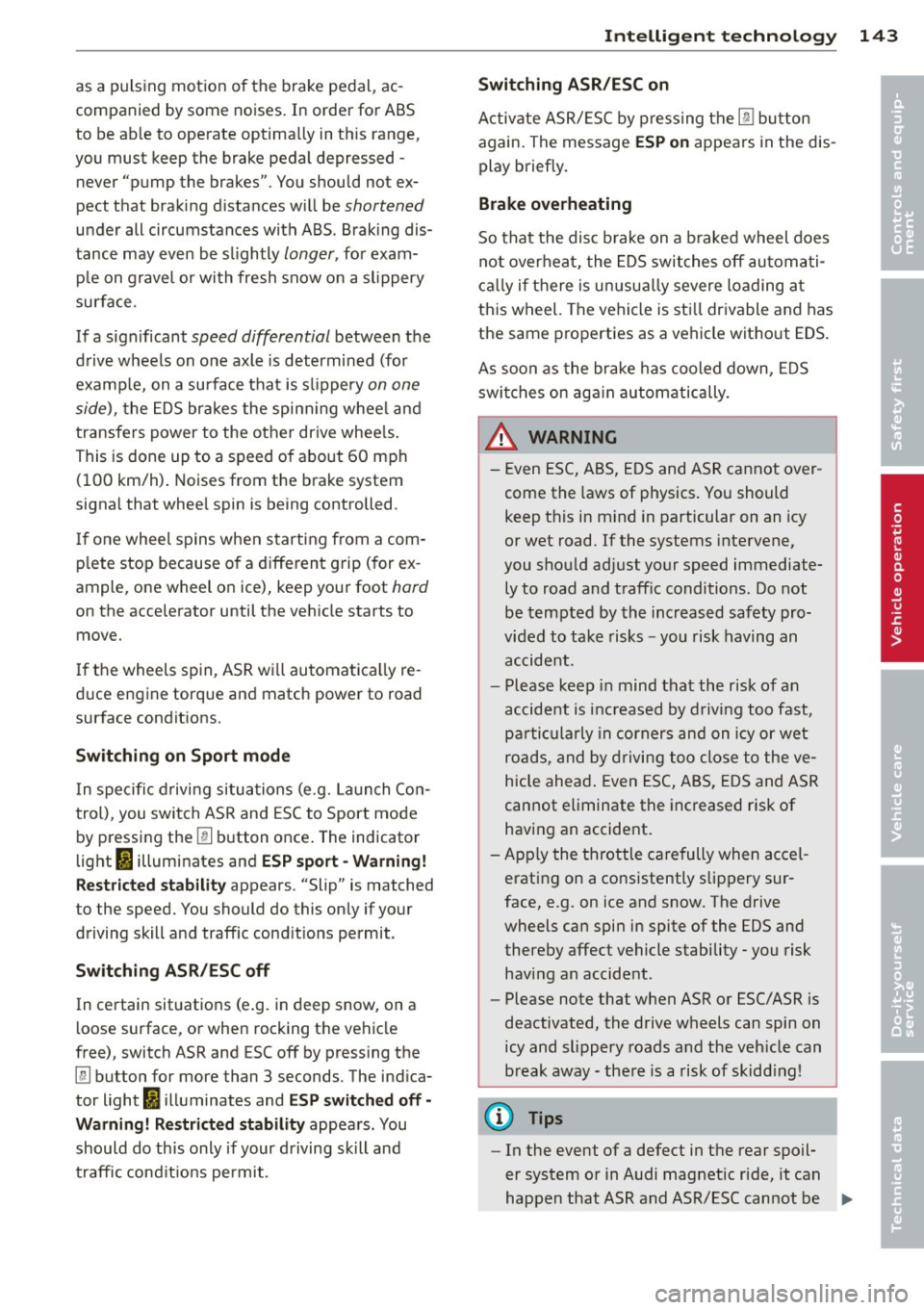
as a pulsing mo tio n of the brake pe dal, ac
companied by some noises. I n order for ABS
to be a ble to operate optimally in th is range,
you must keep the brake pedal depressed -
never "pump the brakes" . You should not ex
pect that braking d is tances w ill be
shortened
under all circumstances w ith ABS . Braking dis
tance may even be slightly
longer , for exam
p le on gravel or wi th fresh snow on a slippery
surface .
If a sign ificant
speed differential between the
d rive w heels on one axle is determined (for
examp le, on a su rface that is s lippery
on one
side),
t he EDS brakes the spinn ing whee l and
transfers power to the other drive whee ls.
This is done up to a speed of about 60 mph (100 km/h) . Noises from the brake system
signal that whee l spin is being controlled.
I f one wheel spins when s tarting from a com
p lete stop because o f a different grip (for ex
ample , one wheel o n ice), keep your foot
hard
on the acce lerator until the veh icle starts to
move.
If the wheels spin , ASR wi ll automatically re
duce engine torque and match power to road
su rface condit ions .
Switching on Sport mode
In specific drivi ng situa tions (e.g. La unch Con
trol), you switch ASR and ESC to Sport mode
by pressing the
[!I button once . The indicator
light
11 illuminates and ESP sport -Warning!
Restricted stability
appears . "Slip" is matched
to the speed. You should do this only if your
driving skill a nd traffic cond it ions permit .
Switching ASR /ESC off
In certain sit uat ions (e .g . in deep snow, on a
l oose surface, o r when rocking the vehicle
free), switch ASR and ESC off by pressing the
[ill button for more than 3 seconds. The ind ica
tor light
II i lluminates and E SP swit ched off -
Warning! Re stricted stability appea rs . You
should do th is only if your driving skill and
traffic cond it io ns pe rmit .
Int ellig ent technolog y 143
Switching ASR /ESC on
Activate ASR/ ESC by pre ssing the [!I bu tton
again. The message
ESP on appears in the dis
play briefly.
Brake overheating
So that the disc b rake on a b raked wheel does
not over heat, the EDS switche s off au toma ti
ca lly if there is un usua lly severe loa ding a t
th is wheel. The vehicle is st ill drivable and has
the same properties as a vehicle without EDS .
As soon as the brake has coo le d down, EDS
swi tches on aga in automatically .
A WARNING
- Even ESC, ABS, EDS and AS R cannot over
come the laws of physics . You should
keep t his in m ind in particular on an icy
or wet road. If the systems intervene,
you shou ld ad just your speed immediate
ly to road and traff ic conditions . Do not
be tempted by the increased safety pro
vided to take risks -you risk having an
accide nt.
- Please keep in mind that the risk of an
accident is i ncreased by d riving too fast,
pa rti cularly in corners and on icy or wet
ro ads, and by drivi ng too close to the ve
hicle ahead . Even ESC, ABS, E DS and A SR
cannot eliminate the increased risk of
having an accident.
-Apply the throttle ca re fully when accel
erating on a consistently s lippery sur
face, e .g. on ice and snow . The drive
wheels can spin in spite of the EDS and thereby affect vehicle stability -you risk
having an accide nt.
- Please note that when ASR or ESC/ASR is
deactivated , the drive wheels can spin on
icy and sl ippery roads a nd the veh icle can
break away -the re is a risk of skidd ing!
(D Tips
- In the event of a defect in the rear spoil-
er system or in Audi magnet ic ride, it can
happen that ASR and ASR/ESC cannot be .,.
•
•
Page 146 of 236
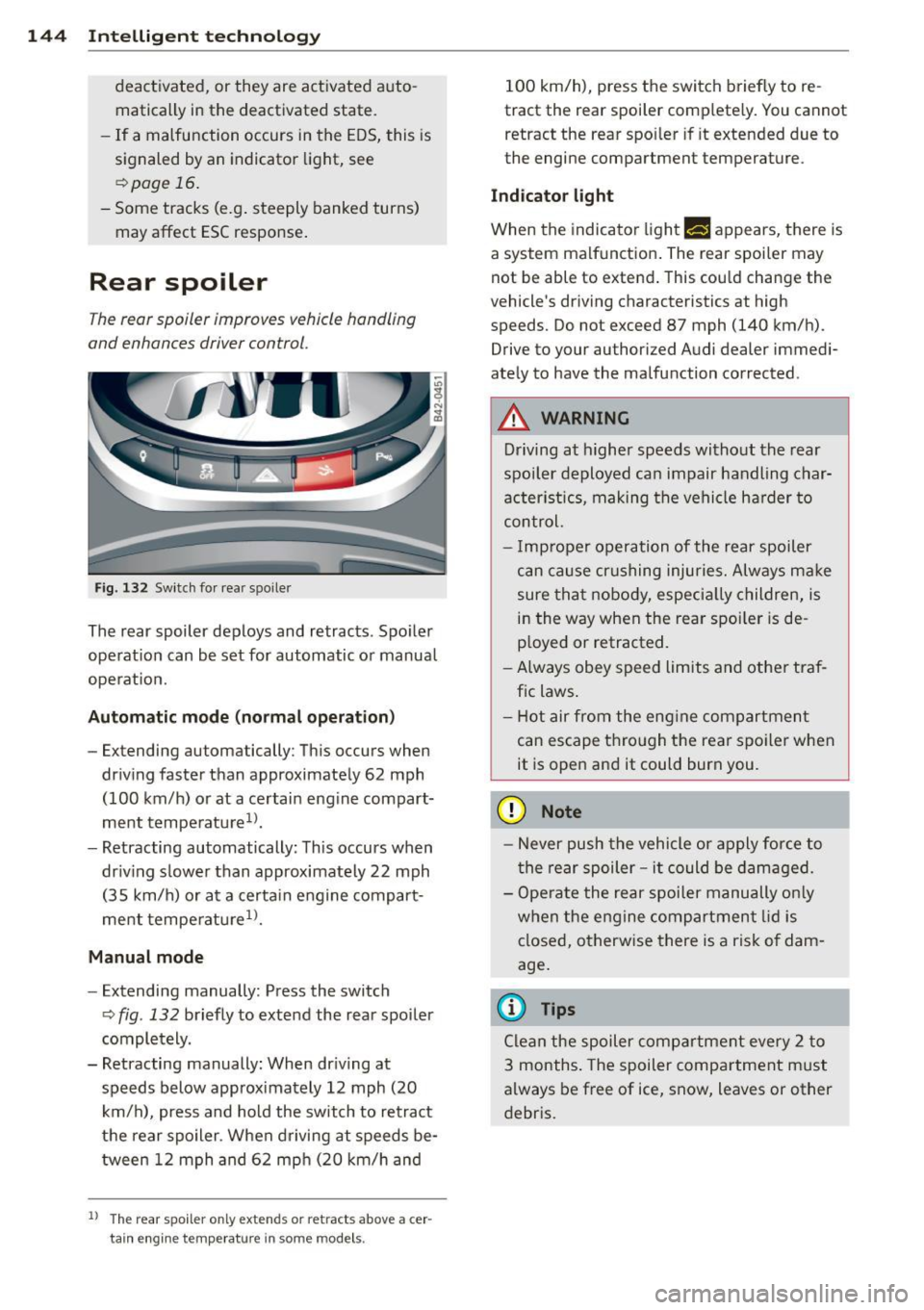
144 Intelligent technology
deactivated, or they are activated auto
matically in the deactivated state.
- If a malfunction occurs in the E DS, this is
signaled by an indicator light, see
~ page 16.
- Some tracks (e.g . steeply banked turns)
may affect ESC response .
Rear spoiler
The rear spoiler improves vehicle handling
and enhances driver control.
Fig. 132 Switch for rear spoile r
The rear spoiler deploys and retracts . Spo ile r
ope rat ion can be set for automatic or manual
operat ion.
Automatic mode (no rmal operation )
-Extending automatically: This occurs when
dr iv ing faster than approximately 62 mph
(100 km/h) or at a certain eng ine compart
ment temperature
1>.
- Retracting automatically: This occurs when
dr iv ing s lower than approximately 22 mph
(35 km/h) o r at a certa in engine compart
ment temperatu re
1>.
Manual mode
- Extending manually: Press the switch
~ fig. 132 briefly to exte nd the rear spoiler
completely .
- Retracting manually : When dr iv ing at
speeds below approx imately 12 mph (20
km/h), press and hold the switch to retract
the rear spo iler. When driving at speeds be
tween 12 mph and 62 mph (20 km/h and
l ) The rear s poiler only extends or retracts above acer
ta in eng in e te mpe rature in some models.
100 km/h), press the switch briefly to re
tract the rear spoiler complete ly. You cannot
retract the rear spo iler if it extended due to
the engine compartment temperature.
Indicator light
When the indicato r light f.-j appears, there is
a system malfunction . The rear spoiler may
not be able to extend . This cou ld change the
vehicle's dr iving characteristics at high
speeds. Do not exceed 87 mph (140 km/h).
Drive to your authorized Audi dealer immed i
ately to have the malfunction corrected .
A WARNING
Driving at higher speeds without the rear
spoiler deployed can impair handling char
acteristic s, making the ve hicle ha rder to
control.
- I mp rope r operation of the rear spoiler
c a n cau se crushing injuries . Always ma ke
sure tha t nobo dy, espec ia lly children, is
i n the way when the rear spoi ler is de
p loyed or retracted.
- Always obey speed limits and other traf
fic laws .
- H ot air from the eng ine compartmen t
can escape thro ugh the rear spo iler when
it is open and it could burn you.
(D Note
- N ever push the vehicle or apply force to
t he rear spoiler -it co uld be damaged.
- Ope rate the rear spoiler manually on ly
w hen the eng ine compartmen t lid is
closed, o therwise there is a r is k of dam
age .
(D Tips
Clean the spoiler comp artme nt eve ry 2 to
3 months . The spoiler compa rtment m ust
a lway s be free of ice, snow, leaves or other
debr is.
Page 147 of 236
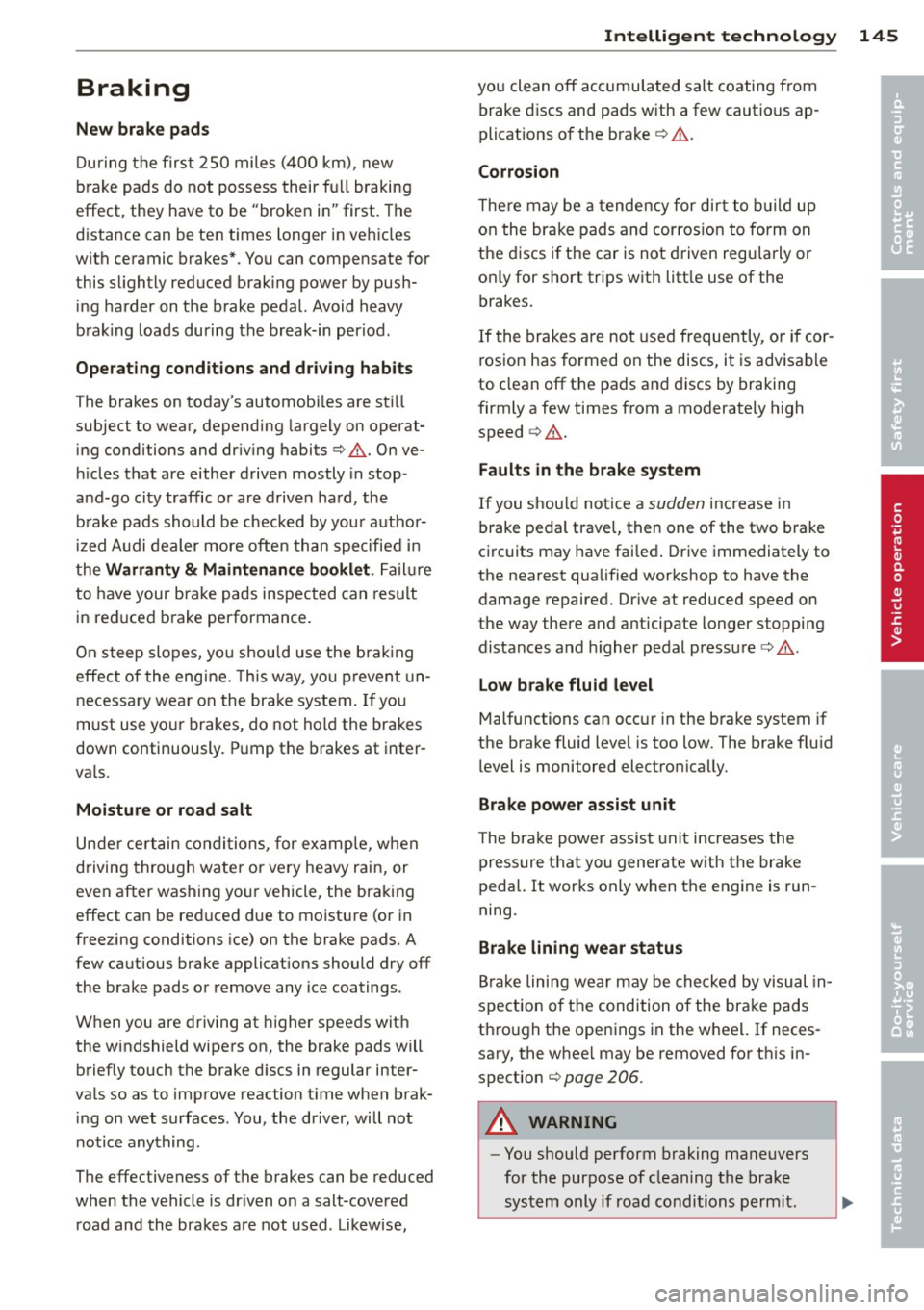
Braking
New brake pads
During the first 250 miles (400 km), new
b rake pads do not possess their full braking
effect, they have to be "broken in" first. The
distance can be ten times longer in veh icles
with ceramic brakes*. You can compensate for
this slightly reduced brak ing power by push
ing harder on the brake pedal. Avoid heavy
braking loads during the break-in period.
Operating conditions and driving habits
The brakes on today's automobi les are sti ll
subject to wear, depending largely on operat
ing conditions and dr iv ing habits
c:> & . On ve
hicles that are either driven mostly in stop
and-go city traffic or a re driven hard, the
brake pads should be checked by your author
ized Audi dealer more often than specified in
the
Warranty & Maintenan ce booklet . Failure
to have your b rake pads inspected can result
in reduced brake performance.
On steep slopes, you shou ld use the brak ing
effect of the engine. This way, you prevent un
necessary wear on the brake system . If you
must use your brakes, do not hold the brakes
down continuously. Pump the brakes at inter
va ls.
Moisture or road salt
Under ce rta in conditions, for example, when
d riving through water or very heavy rain, or
even after washing your vehicle, the braking
effect can be reduced due to moisture (or in
freezing conditions ice) on the brake pads. A
few cautious brake applicat ions should dry
off
the brake pads or remove any ice coatings.
When you are driving at higher speeds with
the windshield wipers on, the brake pads will
briefly touch the brake d iscs in regular inter
vals so as to improve reaction t ime when brak
ing on wet surfaces. You, the driver, will not
notice anything.
The effectiveness of the brakes can be reduced
when the vehicle is dr iven on a salt-covered
road and the brakes are not used . Likewise,
Intelligent technology 145
you clean off accumulated salt coating from
brake discs and pads with a few cautious ap
plications of the brake
c:> & .
Corrosion
The re may be a tendency for dirt to build up
on the brake pads and corros ion to form on
the discs if the car is not driven regularly or
on ly for short trips with litt le use of the
brakes.
If the brakes are not used frequently, o r if cor
rosion has formed on the discs, it is advisable
to clean
off the pads and discs by braking
firmly a few times from a moderately high
speed
c:> & .
Faults in the brake system
If you shou ld notice a sudden increase in
brake pedal travel, then one of the two brake
circuits may have fai led . Drive immediately to
the nearest qualified workshop to have the
damage repaired. Drive at reduced speed on
the way there and anticipate longer stopping
distances and higher pedal pressure c:> &,.
Low brake fluid level
Malfunctions can occur in the brake system if
the brake fluid level is too low. The brake flu id
level is monitored electronically.
Brake power assist unit
T he brake power assist unit increases the
pressure that you generate with the brake
pedal. It works only when the engine is run
ning.
Brake lining wear status
Brake lining wear may be checked by visual in
spection of t he condition of the brake pads
thro ugh the openings in the wheel. If neces
sary, the whee l may be removed for this in
spection
c:> page 206 .
A WARNING
--You should perform braking maneuvers
for the purpose of cleaning the brake
system only if road conditions permit.
•
•
Page 148 of 236
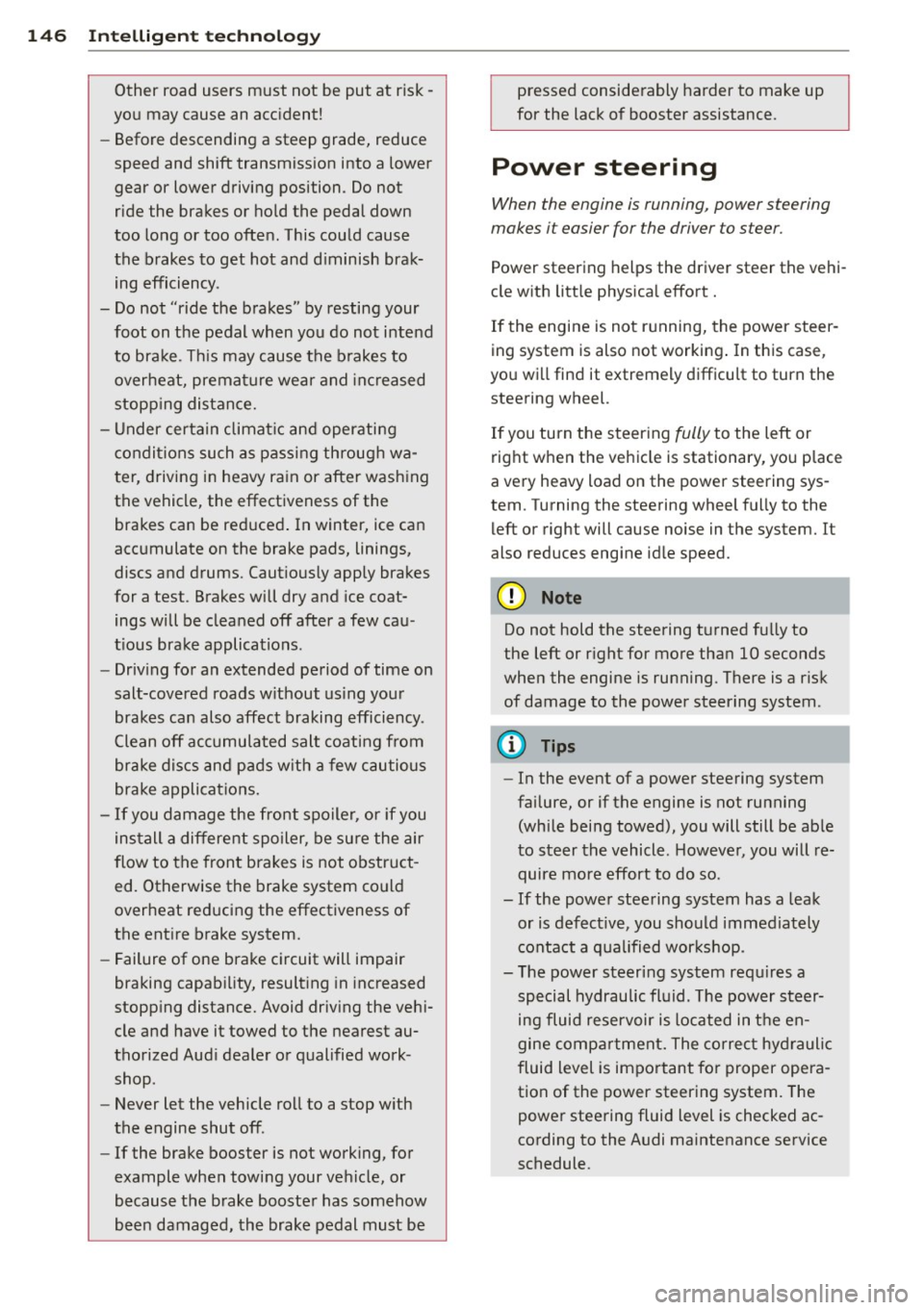
146 Intellig ent technolog y
Other road users must not be put at risk -
yo u may cause an acc ident!
- Before descending a steep grade, reduce
speed and shift transmission into a lower
gear or lower driving position . Do not
ride the brakes or ho ld the pedal down
too long or too often . This cou ld cause
the brakes to get hot and d iminish brak
ing efficiency .
- Do not "ride the brakes" by resting your
foot on the pedal when you do not intend
to brake . Thi s may cause the b rakes to
overheat, premature wea r and inc reased
stopp ing distance.
- Under certain climat ic and operating
condit ions such as passing through wa
ter, driving in heavy ra in or after wash ing
the vehicle, the effectiveness of the
brakes can be reduced . In winter, ice can
accumulate on the brake pads, linings,
discs and drums. Cautiously apply brakes
for a test . Brakes will dry and ice coat
ings w ill be cleaned off after a few cau
t ious brake applications .
- Driv ing for an extended period of time on
salt-covered roads w ithout us ing your
brakes can also affect braking efficiency .
Clean off accumulated salt coating from
brake discs and pads w ith a few cautious
brake applicat ions.
- If you damage the front spoiler, or if you
ins tall a different spoiler, be su re the air
flow to the front brakes is not obstruct
ed. Otherwise the brake system co uld
overheat red ucing the effectiveness of
the ent ire brake system.
- Failure of one brake circuit will impair
braking capab ility, resulting in increased
stopp ing distance. Avoid driv ing the vehi
cle and have it towed to the nearest au
thorized Aud i dealer or qualified work
shop .
- Never let the vehicle roll to a stop w ith
the engine shut off .
- If the brake booster is not working, for
example when tow ing your vehicle, or
because the b rake booste r has somehow
been damaged, the brake pedal must be pressed considerably harder to make up
for the lack of booster assistance .
Power steering
When the engine is running, power steering
makes i t easier for the driver to s teer .
Power steering helps the driv er steer the vehi
cle with litt le physica l effort.
If the engine is not running, the power steer
ing system is also not working . In this case ,
you wi ll find it extremely d ifficu lt to turn the
steering wheel.
If you turn the steering fully to the left or
rig ht when the vehicle is stationary, you p lace
a very heavy load on the power steering sys
tem. Turning the steering wheel fully to the left or right will cause noise in the system. It
also reduces engine id le speed.
(D Note
Do not hold the steering t urned fu lly to
the left or r ight for more than 10 seconds
when the engine is running . There is a r isk
of damage to the power steering system .
(D Tips
-In the event of a power steering system
failure, or if the engine is not running
(while being towed), you will still be ab le
to steer the vehicle. However, you will re
quire more effort to do so .
- If the powe r stee ring system has a leak
or is defect ive , you should immediately
contact a qualified wor kshop .
- The power steer ing system req uires a
special hydraulic fl uid. The power steer
ing fluid reservoir is located in t he en
gine comp artment. The co rrect hydrauli c
fluid level is important for proper opera
tion of the power steering system. The
power steering fluid level is checked ac
cording to the Audi maintenance service
schedule.
Page 149 of 236
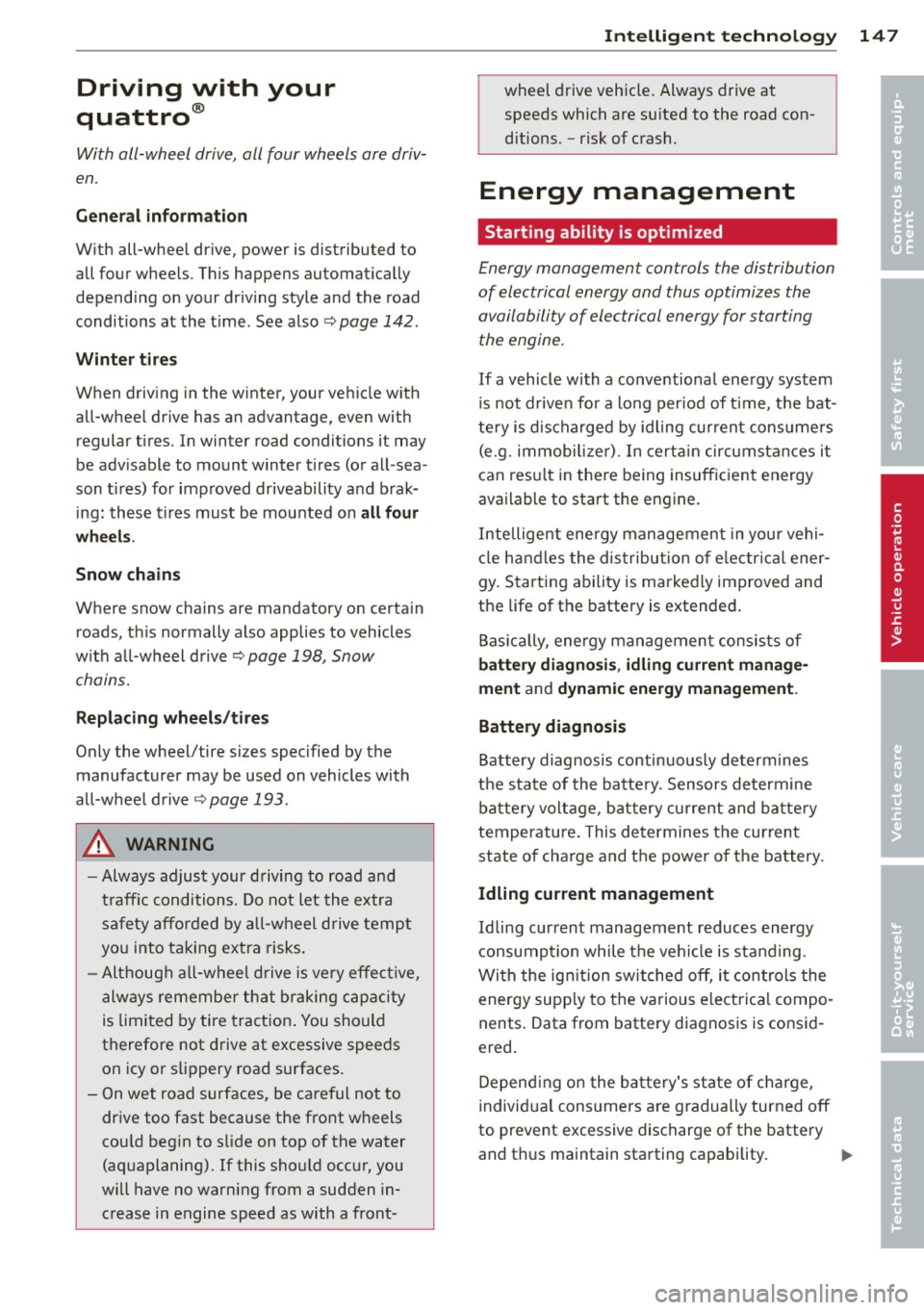
Driving with your
quattro ®
With all-wheel drive, all four wheels are driv
en .
Gene ral inform ation
W ith all-wheel dr ive, power is distributed to
all four wheels . This happens automatically
depending on your driving style and the road
conditions at the t ime . See also <::;>
page 142.
Winter t ires
When driving in the winter, your vehicle with
all-wheel drive has an advantage, even with
regular tires. In winter road conditions it may
be advisable to mount winter tires (or all -sea
son t ires) for improved driveability and brak
ing: these tires must be mounted on
a ll f our
wheel s.
Snow chain s
Where snow chains are mandatory on certain
roads, th is normally also applies to vehicles
with all-wheel drive
Qpage 198, Snow
chains.
Replacing wheel s/tire s
Only the wheel/tire sizes specified by the
manufacturer may be used on vehicles with
all-wheel drive
<=> page 193 .
A WARNING
-Always adjust your driving to road and
traffic conditions. Do not let the extra
safety affo rded by a ll-wheel d rive tempt
you into taking extra risks .
- Although a ll-wheel drive is ve ry effect ive,
always remember that braking capacity
is limited by tire traction . You should
therefore not drive at excessive speeds
on icy or slippery road surfaces.
- On wet road surfaces, be careful not to drive too fast because the front wheels
cou ld begin to slide on top of the water
(aquaplaning). If this should occur, you
will have no warning from a sudden in crease in engine speed as with a front-
-
Int ellig ent technolog y 147
wheel drive vehicle. Always drive at
speeds which are su ited to the road con
ditions. -risk of crash.
Energy management
Starting ability is optimized
Energy management controls the distribution
of electrical energy and thus optimizes the
availability of electrical energy for starting the engine.
If a vehicle with a conventional energy system
is not driven for a long per iod of t ime, the bat
te ry is d ischarged by idling current consumers
(e .g. immobi lizer). In certain circumstances it
can resu lt in the re being insufficient energy
available to start the engine.
Intelligent energy management in your vehi
cle handles the distribution of e lectr ica l ene r
gy. Starting ability is markedly improved and
the life of the battery is extended .
Bas ica lly, energy management consists of
b atte ry diag nosis, idling current m an age
m ent
and dy namic energ y manag ement .
Batte ry diagno sis
Battery diagnosis continuously determines
the state of the batte ry. Sensors determine
battery voltage, battery current and batte ry
temperature . This determines the current
state of charge and the power of the battery.
Idling current manag ement
Idling current management reduces energy
consumption while the vehicle is standing.
Wi th the ign ition switched off, it controls the
energy supply to the various electrica l compo
nents. Data from battery diagnosis is consid
ered.
Depend ing on the ba ttery's state of charge,
individual cons umers are gradually turned off
to prevent excessive discharge of the battery
and thus maintain starting capability. .,..
•
•
Page 150 of 236
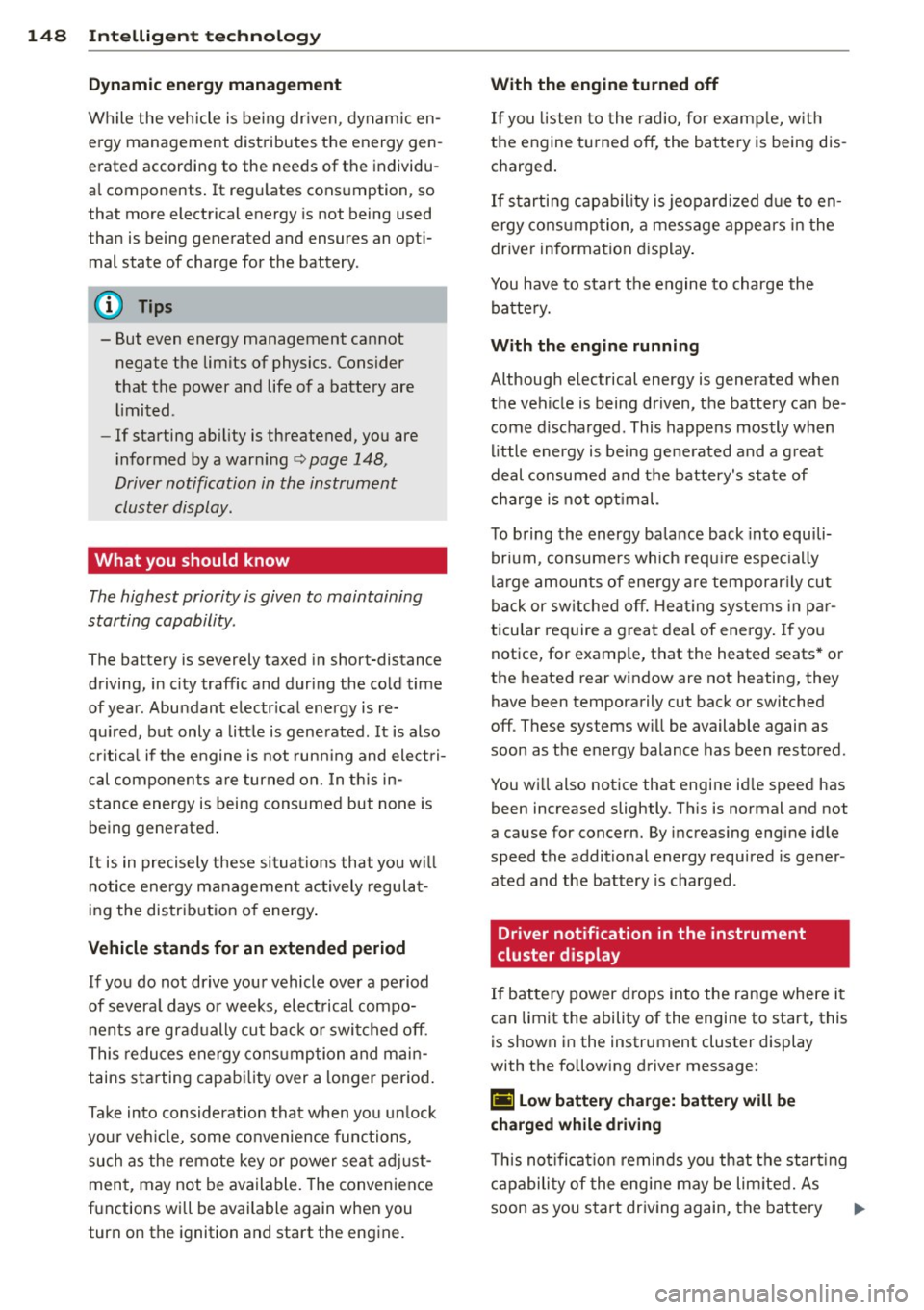
148 Intelligent technology
Dynamic energy management
While th e veh icle is be ing dr iven , dynamic en
e rgy management distributes the energy gen
erated according to the needs of the individu
a l components . It reg ulates cons umption, so
that more electrical energy is not being used
t han is being generated and ensures an opti
mal state of charge for the battery .
(D Tips
- But even energy management cannot
negate the limits of physics. Consider
that the power and life of a battery are li mited .
- If starting ab ility is threatened, you are
i nformed by a warn ing
<=> page 148,
Driver notification in the instrument
cluster display .
What you should know
The highest priority is given to maintaining
starting capability.
The battery is severely taxed in short-distance
d riving, in city traffic and duri ng the co ld time
of year. Abu ndant e lectr ica l energy is re
qu ired, but only a little is g ene rated . It is also
cr itica l if t he engine is not run ning and ele ct ri
cal componen ts ar e turned on. In th is in
stance energy is being consumed but none is
being generate d.
It is in precisely these si tua tions that you w ill
notice energy management actively regula t
ing the distrib ution o f energy .
Vehicle stands for an extended period
If you do not drive you r vehicle over a period
of severa l days or weeks, elect rical compo
n ents are grad ually cu t back o r swi tched off .
This redu ce s energy cons umption and mai n
tains s ta rting cap abili ty over a longer period .
T a ke into considerat ion tha t when you u nlock
your ve hicle, some co nvenience func tions,
such as the remote key or power sea t adj ust
men t, may not be available. The convenience
f u nctions will be avai lable again when you
turn on th e ignition and start the engine. With the engine turned off
If you
listen to the radio, for examp le, w it h
t h e engine t urned off, the battery is being dis
c h arged .
If starti ng capab il ity is jeopard ized d ue to en
ergy consu mptio n, a mess age a ppea rs in the
drive r informa tion d isplay .
You have to start t he engine to charge the
ba tte ry.
With the engine running
Althoug h electrical energy is generated when
the vehicle is being d riven, the battery can be
come discharged. This happens mostly when
li ttle energy is being ge ne rated and a g reat
deal consumed a nd t he battery's state of
c h arge is not opt imal.
To b ring the energy bala nce back into equ ili
br iu m , consume rs wh ich req uire espe cially
l ar ge amounts of ene rgy a re temporar ily cu t
ba ck or sw itched o ff. H ea ting systems in par
t icu lar require a grea t deal of energy . If you
not ice, for examp le, that the heated seatsat or
the heated rear window are not heating, they have been temporarily cut back or switched
off . These systems w ill be available again as
soon as the e ne rgy balance has been restored.
You w ill also notice that engine id le speed has
been increased slightly . T hi s is normal and not
a cause for concern. By increasing engine id le
speed the additional energy required is gener
ated and the battery is charged .
Driver notification in the instrument
cluster display
If bat tery power drops in to the range where i t
can limit the ability of the engi ne to start, this
is shown in the instrument cluster display
with the following driver message:
(•] Low battery charge: battery will be
charged while driving
T h is not ifi cat io n r eminds yo u that t he start ing
ca pabili ty of the engi ne may be lim ite d. As
soon as you s tart dr iv ing again, the battery .,..